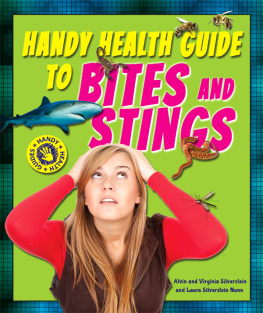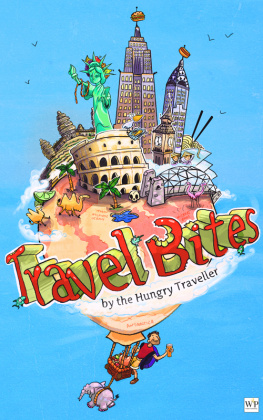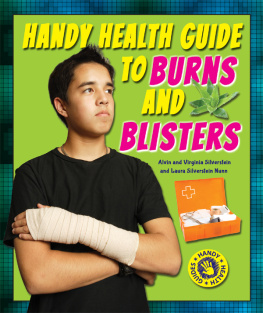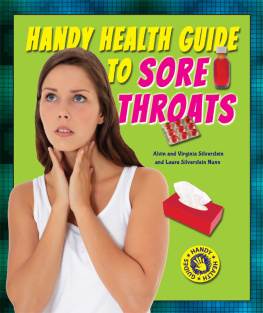OUCH! WHAT JUST BIT ME?
We all face health problems once in a while. Maybe you got stung by a bee or caught a cold. Perhaps you have asthma or diabetes. Some people need glasses to see better or are allergic to peanut butter. These handy guides teach you about your health and how all the parts of your body work together to keep you healthy most of the time.
About the Author
Dr. Alvin Silverstein is a retired professor of biology at the College of Staten Island, City University of New York. Virginia Silverstein translates scientific Russian and is a professional author. Together they have written more than 200 books for young people. Laura Silverstein Nunn has coauthored more than 100 books with her parents.

Image Credit: Sanjay Goswami/Photos.com
Who could resist picking such beautiful flowers? But beware, bees love them too!
Youd know that annoying whining sound anywhere. It means theres a pesky mosquito flying around your head. You try to smack the insect, but its too late. It has already bitten you.
Youre picking flowers in the yard and notice a bee flying close to you. You try to wave it away, but the insect stings you anyway. Ouch! That bee sting really hurts.
Insects are not the only creatures that can hurt you. A neighbors dog could get loose and sink its sharp teeth into your leg. If you are swimming in the ocean and bump into a jellyfish, you might get stung. Animals bite and sting for two reasonsto protect themselves from danger and to get food.
A mosquito bite or a bee sting can usually be treated at home. A dog bite or a scorpion sting can be more serious. If these animals attack you, you should see a doctor right away. In some cases, you may need to go to the hospital. Sometimes its hard to know how serious a bite or sting is. Thats why you should always tell an adult about your injury.

When an animal bites you, it sinks its mouthparts into your skin. When an animal stings you, a pointed stinger on its rear end shoots poison into your body. Mosquitoes, fleas, ticks, cats, dogs, or mice can bite you. Bees, wasps, jellyfish, scorpions, and stingrays can sting you.

Image Credit: Shutterstock.com
Creepy crawlies didnt get their name by accident. Many people think of bugswhether they fly or crawlas plain creepy. But some are also a real painliterally. Mosquitoes, fleas, and ticks, for example, may try to drink your blood. Bees, wasps, and scorpions can give you a painful sting. Bites from spiders and ants can hurt a lot too.
When a mosquito lands on you, it cuts into your skin with its needlelike proboscis. The proboscis is a long tube that the mosquito uses to suck up your blood. As soon as the insect injects saliva into you, the bite starts to sting and itch. Mosquito saliva contains chemicals that keep blood from clotting, so your blood flows freely into the insects body. Females are actually the only mosquitoes that bite. They need the blood meal to help develop their mosquito eggs.

Image Credit: James Gathany/CDC
Have you ever seen a mosquito this close up? In a matter of seconds, it can pierce your skin, suck your blood, and then be on its way.
Fleas are not picky eaters. They like to feed on the blood of dogs and cats, but they are just as happy to feast on you. You may feel one of these tiny, blood-sucking insects on your skin, but they are hard to spot. And they are even harder to catch.
Fleas move fast, and they are champion jumpers. A flea can jump 8 inches (20 centimeters) high in the air and leap as far as 13 inches (33 cm). That may not sound like a lot, but think of it this way: If a flea were the size of a person, it would have no trouble leaping over two football fields.
A flea uses its sharp beak to pierce through skin. Then it injects its saliva into the wound and drinks up a blood meal. Like other insect bites, flea bites are itchy and irritating.

Image Credit: Shutterstock.com
Flea bites can feel really itchy and annoying, but scratching can make them even worse.

Image Credit: AP Images/David Guttenfelder
This tiny flea is magnified many times.
Wasps and bees are usually drawn to colorful patterns and strong-smelling things. Thats why you often see them flying around flowers, picnic lunches, and garbage dumps. These insects do not normally attack people. But if you swat at one or disturb its nest, it might just sting you.
Hornets and yellow jackets are wasps. If one of these insects stings you, it probably will not leave its stinger behind. Neither will a bumblebee. But if a honeybee stings you, it will leave its stingeralong with a tiny sac of venom (poison)in your skin. Even after the bee has flown away, the stinger will continue to pump out venom. The longer the stinger stays in the skin, the more the wound will hurt. So its important to get the stinger out as soon as possible.
Interestingly, a honeybee wont get a chance to sting a second time. Honeybees die after they sting. Thats because the honeybees stinger has spiky barbs on it, like a fishhook, and it gets stuck and breaks off when the bee flies away. Losing the stinger injures the honeybee so badly that it will die.

Image Credit: AP Images/St. Cloud Times, Paul Middlestaedt
If you bother a honeybee, it may sting you. When the bee flies away, it may leave its stinger in you.
All spiders use venom to kill their prey. But the venom of most spiders is not strong enough to hurt people. Only two kinds of dangerous spiders live in North Americathe black widow spider and the brown recluse spider.
The black widow spider is most common in the southern United States. Its poisonous bite is very painful, and it can be deadly. It is easy to identify a black widow spider. Just look for a red mark shaped like an hourglass on the underside of its abdomen.

Image Credit: Shutterstock.com
Take a look at the two most dangerous spiders in North America: the black widow spider (a) and the brown recluse spider (b).
The brown recluse spider lives in the southern and central United States. It is brown and has a black mark shaped like a violin on its back. These spiders usually spin webs in dark places, such as basements or woodpiles. You might not even notice themuntil you feel their painful bite. If a brown recluse spider bites you, you should go to the hospital right away.























